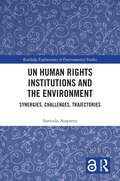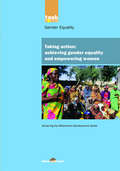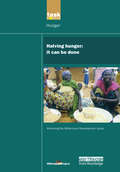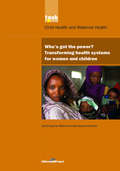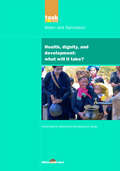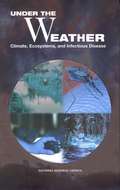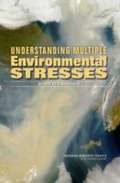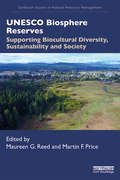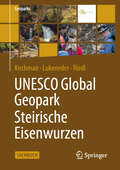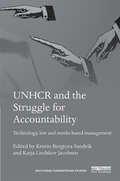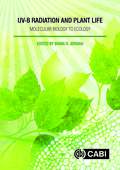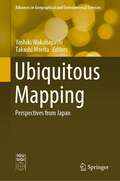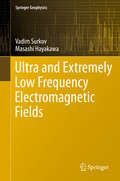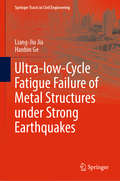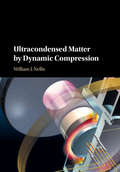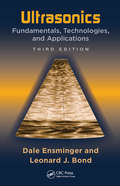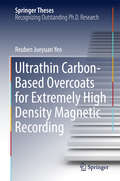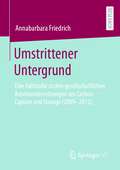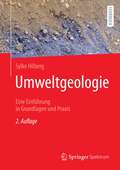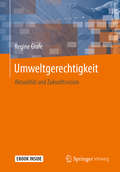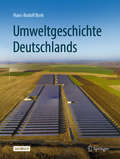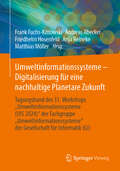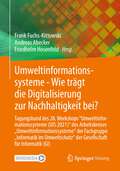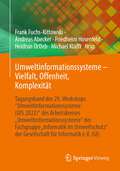- Table View
- List View
UN Human Rights Institutions and the Environment: Synergies, Challenges, Trajectories (Routledge Explorations in Environmental Studies)
by Sumudu AtapattuThis book presents an in-depth analysis of how UN Human Rights institutions and mechanisms have addressed environmental protection, sustainable development and climate change. Despite the increasing involvement of UN human rights bodies in addressing environmental degradation and climate change, a systematic review of the convergence between human rights and the environment in these bodies has not been carried out. Filing this lacuna, this book surveys the resolutions, general comments, concluding observations, decisions on individual communications and press releases. It identifies principles that have emerged, explores the ways in which human rights Charter-based and treaty-based institutions are interpreting environmental principles and examines how they contribute to the emerging field of human rights and environment. Given the disproportionate effect that polluting activities have on marginalized and vulnerable groups, Atapattu also discusses how these human rights mechanisms have addressed the impact on women, children, indigenous peoples, people with disabilities and racial minorities. Written by a world-renowned expert on human rights and the environment, this book will be of great interest to students and scholars researching and teaching in this important field of study.
UN Millennium Development Library: Achieving Gender Equality and Empowering Women
by UN Millennium ProjectThe Millennium Development Goals, adopted at the UN Millennium Summit in 2000, are the world's targets for dramatically reducing extreme poverty in its many dimensions by 2015 income poverty, hunger, disease, exclusion, lack of infrastructure and shelter while promoting gender equality, education, health and environmental sustainability. These bold goals can be met in all parts of the world if nations follow through on their commitments to work together to meet them. Achieving the Millennium Development Goals offers the prospect of a more secure, just, and prosperous world for all. The UN Millennium Project was commissioned by United Nations Secretary-General Kofi Annan to develop a practical plan of action to meet the Millennium Development Goals. As an independent advisory body directed by Professor Jeffrey D. Sachs, the UN Millennium Project submitted its recommendations to the UN Secretary General in January 2005. The core of the UN Millennium Project's work has been carried out by 10 thematic Task Forces comprising more than 250 experts from around the world, including scientists, development practitioners, parliamentarians, policymakers, and representatives from civil society, UN agencies, the World Bank, the IMF, and the private sector. This report lays out the recommendations of the UN Millennium Project Task Force on Education and Gender Equality. The Task Force recommends seven strategic priorities: strengthen postprimary education for girls while ensuring universal primary education; guarantee sexual and reproductive health and rights; reduce women's and girls' time burdens; guarantee property and inheritance rights; eliminate gender inequality in employment; increase women's participation in government; and significantly reduce violence against women. Action on these priorities will enable countries in every region of the world to achieve gender equality and women's empowerment by 2015.
UN Millennium Development Library: It Can Be Done
by UN Millennium ProjectThe Millennium Development Goals, adopted at the UN Millennium Summit in 2000, are the world's targets for dramatically reducing extreme poverty in its many dimensions by 2015 income poverty, hunger, disease, exclusion, lack of infrastructure and shelter while promoting gender equality, education, health and environmental sustainability. These bold goals can be met in all parts of the world if nations follow through on their commitments to work together to meet them. Achieving the Millennium Development Goals offers the prospect of a more secure, just, and prosperous world for all. The UN Millennium Project was commissioned by United Nations Secretary-General Kofi Annan to develop a practical plan of action to meet the Millennium Development Goals. As an independent advisory body directed by Professor Jeffrey D. Sachs, the UN Millennium Project submitted its recommendations to the UN Secretary General in January 2005. The core of the UN Millennium Project's work has been carried out by 10 thematic Task Forces comprising more than 250 experts from around the world, including scientists, development practitioners, parliamentarians, policymakers, and representatives from civil society, UN agencies, the World Bank, the IMF, and the private sector. This report lays out the recommendations of the UN Millennium Project Task Force on Hunger in seven major categories: political action; national policy reforms; increased agricultural productivity for food insecure farmers; improved nutrition for the chronically hungry; productive safety nets for the acutely hungry; improved rural incomes and markets; and restoration and conservation of natural resources essential for food security. The task force strongly endorses the Secretary General's call for a 21st Century African Green Revolution. These bold yet practical approaches will enable countries in every region of the world to halve world hunger by 2015.
UN Millennium Development Library: Transforming Health Systems for Women and Children
by UN Millennium ProjectThe Millennium Development Goals, adopted at the UN Millennium Summit in 2000, are the world's targets for dramatically reducing extreme poverty in its many dimensions by 2015 income poverty, hunger, disease, exclusion, lack of infrastructure and shelter while promoting gender equality, education, health and environmental sustainability. These bold goals can be met in all parts of the world if nations follow through on their commitments to work together to meet them. Achieving the Millennium Development Goals offers the prospect of a more secure, just, and prosperous world for all. The UN Millennium Project was commissioned by United Nations Secretary-General Kofi Annan to develop a practical plan of action to meet the Millennium Development Goals. As an independent advisory body directed by Professor Jeffrey D. Sachs, the UN Millennium Project submitted its recommendations to the UN Secretary General in January 2005. The core of the UN Millennium Project's work has been carried out by 10 thematic Task Forces comprising more than 250 experts from around the world, including scientists, development practitioners, parliamentarians, policymakers, and representatives from civil society, UN agencies, the World Bank, the IMF, and the private sector. This report lays out the recommendations of the UN Millennium Project Task Force on Child and Maternal Health. The Task Force recommends the rapid and equitable scale-up of interventions like the Integrated Management of Childhood Illness, the universal provision of emergency obstetric care, and sexual and reproductive health services and rights be provided through strengthened health systems. This will require that health systems be seen as social institutions to which all members of society have a fundamental right. This bold yet practical approach will enable every country to reduce the under-five mortality rate by two-thirds and the maternal mortality rate by three-quarters by 2015.
UN Millennium Development Library: What Will it Take? (Un\millennium Development Library)
by UN Millennium ProjectThe Millennium Development Goals, adopted at the UN Millennium Summit in 2000, are the world's targets for dramatically reducing extreme poverty in its many dimensions by 2015 income poverty, hunger, disease, exclusion, lack of infrastructure and shelter while promoting gender equality, education, health and environmental sustainability. These bold goals can be met in all parts of the world if nations follow through on their commitments to work together to meet them. Achieving the Millennium Development Goals offers the prospect of a more secure, just, and prosperous world for all. The UN Millennium Project was commissioned by United Nations Secretary-General Kofi Annan to develop a practical plan of action to meet the Millennium Development Goals. As an independent advisory body directed by Professor Jeffrey D. Sachs, the UN Millennium Project submitted its recommendations to the UN Secretary General in January 2005. The core of the UN Millennium Project's work has been carried out by 10 thematic Task Forces comprising more than 250 experts from around the world, including scientists, development practitioners, parliamentarians, policymakers, and representatives from civil society, UN agencies, the World Bank, the IMF, and the private sector. In this report the UN Millennium Project Task Force on Water and Sanitation outlines the bold yet practical actions that are needed to increase access to water and sanitation. The report underscores the need to focus on the global sanitation crisis, which contributes to the death of 3900 children each day, improve domestic water supply, and invest in integrated development and management of water resources, all of which are necessary for countries to reduce poverty and hunger, improve health, advance gender equality and ensure environmental sustainability. Implementing the recommendations of this report will allow all countries to halve the proportion of people without access to safe water and sanitation by 2015.
UNDER THE WEATHER: Climate, Ecosystems, and Infectious Disease
by National Research CouncilSince the dawn of medical science, people have recognized connections between a change in the weather and the appearance of epidemic disease. With today's technology, some hope that it will be possible to build models for predicting the emergence and spread of many infectious diseases based on climate and weather forecasts. However, separating the effects of climate from other effects presents a tremendous scientific challenge.Can we use climate and weather forecasts to predict infectious disease outbreaks? Can the field of public health advance from "surveillance and response" to "prediction and prevention?" And perhaps the most important question of all: Can we predict how global warming will affect the emergence and transmission of infectious disease agents around the world?Under the Weather evaluates our current understanding of the linkages among climate, ecosystems, and infectious disease; it then goes a step further and outlines the research needed to improve our understanding of these linkages. The book also examines the potential for using climate forecasts and ecological observations to help predict infectious disease outbreaks, identifies the necessary components for an epidemic early warning system, and reviews lessons learned from the use of climate forecasts in other realms of human activity.
UNDERSTANDING MULTIPLE Environmental STRESSES: REPORT OF A WORKSHOP
by National Research Council of the National AcademiesThe research of the last decade has demonstrated that ecosystems and human systems are influenced by multiple factors, including climate, land use, and the by-products of resource use. Understanding the net impact of a suite of simultaneously occurring environmental changes is essential for developing effective response strategies. Using case studies on drought and a wide range of atmosphere-ecosystem interactions, a workshop was held in September 2005 to gather different perspectives on multiple stress scenarios. The overarching lesson of the workshop is that society will require new and improved strategies for coping with multiple stresses and their impacts on natural socioeconomic systems. Improved communication among stakeholders; increased observations (especially at regional scales); improved model and information systems; and increased infrastructure to provide better environmental monitoring, vulnerability assessment, and response analysis are all important parts of moving toward better understanding of and response to situations involving multiple stresses. During the workshop, seven near-term opportunities for research and infrastructure that could help advance understanding of multiple stresses were also identified.
UNESCO Biosphere Reserves: Supporting Biocultural Diversity, Sustainability and Society (Earthscan Studies in Natural Resource Management)
by Martin F. Price Maureen G. ReedUNESCO Biosphere Reserves (BRs) are designated areas in geographical regions of global socio-ecological significance. This definitive book shows their global relevance and contribution to environmental protection, biocultural diversity and education. Initiated in the 1970s as part of UNESCO’s Man and Biosphere (MAB) Programme, BRs share a set of common objectives, to support and demonstrate a balance between biodiversity conservation, sustainable development and research. The world’s 701 BRs form an international, intergovernmental network to support the aims of sustainability science, but this purpose has not always been widely understood. In three distinct sections, the book starts by outlining the origins of BRs and the MAB Programme, showing how they contribute to advancing sustainable development. The second section documents the evolution of BRs around the world, including case studies from each of the five UNESCO world regions. Each case study demonstrates how conservation, sustainable development and the role of scientific research have been interpreted locally. The book concludes by discussing thematic lessons to help understand the challenges and opportunities associated with sustainability science, providing a unique platform from which lessons can be learned. This includes how concepts become actions on the ground and how ideas can be taken up across sites at differing scales. This book will be of great interest to professionals engaged in conservation and sustainable development, NGOs, policy-makers and advanced students in environmental management, ecology, sustainability science, environmental anthropology and geography.
UNESCO Global Geopark Steirische Eisenwurzen (Geoparks)
by Gabriel Kirchmair Alexander Lukeneder Wolfgang Christoph RiedlWo sich Kultur und Natur im Einklang befinden Das Buch zeigt das wunderbare Erdmittelalter in den einstigen Meeresbecken des Natur- und Geoparks Steirische Eisenwurzen. Es führt durch gigantische Klimakatastrophen der Erdgeschichte und präsentiert diesen einzigartigen Park als Wunderkammer der Natur. Die Landschaft birgt Naturwunder wie Schneckenfriedhöfe, Massen an Ammoniten, imposante Bechermuschelriffe, Seelilienwälder und Gesteinsformationen mit Kuhtrittmuscheln. Highlights sind das Rätsel um ein verschwundenes Saurierskelett und die gewaltige Katastrophe an der KT-Grenze vor 66 Millionen Jahren. Der UNESCO Global Geopark Steirische Eisenwurzen liegt in den Nördlichen Kalkalpen, in der Mitte Österreichs. Die geologischen Besonderheiten und Landschaftsformen sind einzigartig in Österreich. Die Region besticht durch ihre Kulturgeschichte, Geodiversität und Biodiversität. Landschaften, über Jahrmillionen geprägt, bilden das Fundament für Abenteuer und Geschichten in der heutigen Zeit. Dieses Buch richtet sich an jeden, der geowissenschaftlich interessiert ist und plant, die einzigartige Geologie der Nördlichen Kalkalpen zu erleben und nimmt Sie mit auf eine erdgeschichtliche Entdeckungsreise im ältesten Geopark Österreichs.
UNHCR and the Struggle for Accountability: Technology, law and results-based management (Routledge Humanitarian Studies)
by Kristin Bergtora Sandvik Katja Lindskov JacobsenDespite the key importance of accountability for the legitimacy of humanitarian action, inadequate academic attention has been given to how the concept of accountability is evolving within the specific branches of the humanitarian enterprise. Up to now, there exists no comprehensive account of what we label the 'technologies of accountability', the effects of their interaction, or the question of how the current turn to decision-making software and biometrics as both the means and ends of accountability may contribute to reshaping humanitarian governance. UNHCR and the Struggle for Accountability explores the UNHCR's quest for accountability by viewing the UNHCR's accountability obligations through the web of institutional relationships within which the agency is placed (beneficiaries, host governments, implementing partners, donors, the Executive Committee and UNGA). The book takes a multidisciplinary approach in order to illuminate the various layers and relationships that constitute accountability and also to reflect on what constitutes good enough accountability. This book contributes to the discussion regarding how we construct knowledge about concepts in humanitarian studies and is a valuable resource for academics, researchers and professionals in the areas of anthropology, history, international relations, international law, science, technology studies and socio-legal studies.
UV-B Radiation and Plant Life: Molecular Biology to Ecology
by Marcel Jansen Pedro J. Aphalo Amy T. Austin Carlos L. Ballaré Paul W. Barnes Susanne Baldermann Melanie Binkert Janet F. Bornman Isabelle N. Bottger Stephan D. Flint Franziska S. Hanschen Éva Hideg Gareth I. Jenkins Karel Klem Susanne Neugart Monika Schreiner Åke Strid Mark A. Tobler Roman Ulm Otmar Urban Jason Wargent Melanie WiesnerUltraviolet-B radiation (UV-B) has profound effects on plant growth and development, and exposure varies with ozone depletion and across geographic regions, with ecosystem and agricultural consequences. This book deals with large-scale impacts but also how UV-B affects plants at the molecular level is also fascinating, and the UV-B photoreceptor has only recently been characterised. While UV-B radiation can be damaging, it also has a more positive role in plant photomorphogenesis. Consequently UV-B treatments are being developed as innovative approaches to improve horticulture. This book is a timely synthesis of what we know and need to know about UV-B radiation and plants.
Ubiquitous Mapping: Perspectives from Japan (Advances in Geographical and Environmental Sciences)
by Takashi Morita Yoshiki WakabayashiSince the last decades of the twentieth century, the circumstances surrounding map use and map making have drastically changed owing to advances in information and communication technologies (ICTs). In particular, the spread of web maps and mobile devices have altered the way people interact with maps. This book features the latest works on theoretical and practical issues of these changes by terming them “ubiquitous mapping”. In particular, the book pays attention to not only the technological basis but also multidisciplinary human–social aspects. The book covers the topics of the evaluation of ICT-based technologies for context-aware mapping, the theory and application of crowd-sourced geospatial information and collaborative mapping, and both the positive and negative effects of ubiquitous mapping on human society.
Ultra and Extremely Low Frequency Electromagnetic Fields
by Masashi Hayakawa Vadim SurkovThe major emphasis of this book is on physical mechanisms and sources of the ULF/ELF natural electromagnetic fields noises. In the course of this text, some of these mechanisms of magnetospheric origin will be treated in detail and others in a more sketchy fashion, while the global electromagnetic resonances excited by lightning activity and other sources are the priority. The interested reader is referred to the books cited in the text for details about the ULF/ELF fields of magnetospheric origin. Much emphasis is put on studies of electromagnetic phenomena caused by rock deformation/fracture including the ULF/ELF effects possibly associated with tectonic activity, earthquakes and other natural disasters. One of the challenges of this research is to fully understand electromagnetic effects and physical processes in the rocks deep in the Earth's crust.
Ultra-low-Cycle Fatigue Failure of Metal Structures under Strong Earthquakes (Springer Tracts in Civil Engineering)
by Liang-Jiu Jia Hanbin GeThis book presents experimental results and theoretical advances in the field of ultra-low-cycle fatigue failure of metal structures under strong earthquakes, where the dominant failure mechanism is ductile fracture. Studies on ultra-low-cycle fatigue failure of metal materials and structures have caught the interest of engineers and researchers from various disciplines, such as material, civil and mechanical engineering. Pursuing a holistic approach, the book establishes a fundamental framework for this topic, while also highlighting the importance of theoretical analysis and experimental results in the fracture evaluation of metal structures under seismic loading. Accordingly, it offers a valuable resource for undergraduate and graduate students interested in ultra-low-cycle fatigue, researchers investigating steel and aluminum structures, and structural engineers working on applications related to cyclic large plastic loading conditions.
Ultracondensed Matter by Dynamic Compression
by William J. NellisDynamic compression is an experimental technique with interdisciplinary uses, ranging from enabling the creation of ultracondensed matter under previously impossible conditions to understanding the likely cause of unusual planetary magnetic fields. Readers can now gain an intuitive understanding ofdynamic compression; clear and authoritative chapters examine its history and experimental method, as well as key topics including dynamic compression of liquid hydrogen, rare gas fluids and shock-induced opacity. Through an up-to-date history of dynamic compression research, Nellis also clearly shows how dynamic compression addresses and will continue to address major unanswered questions across the scientific disciplines. The past and future role of dynamic compression in studying and making materials at extreme conditions of pressure, density and temperature is made clear, and the means of doing so are explained in practical language perfectly suited for researchers and graduate students alike.
Ultrasonics: Fundamentals, Technologies, and Applications, Third Edition
by Dale Ensminger Leonard J. BondThe book provides a unique and comprehensive treatment of the science, technology, and applications for industrial and medical ultrasonics, including low- and high-power implementations. The discussion of applications is combined with the fundamental physics, the reporting of the sensors/transducers, and systems for the full spectrum of industrial, nondestructive testing, and medical/bio-medical uses. It includes citations of numerous references and covers both mainstream and the more unusual and obscure applications of ultrasound.
Ultrathin Carbon-Based Overcoats for Extremely High Density Magnetic Recording
by Reuben Jueyuan YeoThis book presents the latest research in ultrathin carbon-based protective overcoats for high areal density magnetic data storage systems, with a particular focus on hard disk drives (HDDs) and tape drives. These findings shed new light on how the microstructure and interfacial chemistry of these sub-20 nm overcoats can be engineered at the nanoscale regime to obtain enhanced properties for wear, thermal and corrosion protection – which are critical for such applications. Readers will also be provided with fresh experimental insights into the suitability of graphene as an atomically-thin overcoat for HDD media. The easy readability of this book will appeal to a wide audience, ranging from non-specialists with a general interest in the field to scientists and industry professionals directly involved in thin film and coatings research.
Umstrittener Untergrund: Eine Fallstudie zu den gesellschaftlichen Auseinandersetzungen um Carbon Capture and Storage (2009-2012)
by Annabarbara FriedrichDie Autorin analysiert die gesellschaftlichen Auseinandersetzungen um den frühen Implementierungsversuch einer Carbon Dioxide Removal Technologie. Diese Maßnahmen sind vom Weltklimarat als ein Baustein zur Eindämmung des Klimawandels anerkannt. Die EU setzte eine solche Technologie, Carbon Capture and Storage (CCS), bereits im Jahr 2009 auf die politische Agenda der Mitgliedstaaten. Die Arbeit untersucht die restriktive Regulierung der Kohlendioxidabscheidung und –speicherung in Deutschland, die im journalistisch-öffentlichen Diskurs auch als gescheitert dargestellt wird. Statt die (fehlende) öffentliche Akzeptanz von CCS zu erklären, untersucht die Arbeit die gesellschaftliche Politisierung des Technologie-Sets. Auf der Grundlage von Theorieansätzen der Science and Technology Studies werden die Deutungsrahmen von Interessengruppen auf Bundesebene analysiert. Die Inhaltsanalyse, der öffentlichen Dokumente von Gesellschaftsakteuren im Kontext des Gesetzgebungsverfahrens (2009-2012), zeigt die Verknüpfung von Carbon Capture and Storage und bestehenden soziotechnischen Systemen sowie deren gesellschaftspolitische Kontexte. Die qualitative Analyse behandelt ein vergangenes Beispiel einer umstrittenen technologischen Intervention. Dies ist zugleich zukunftsweisend, da nachträgliche Methoden der CO2-Entnahme aktuell im Zusammenhang von sog. unvermeidbaren Restemissionen erneut diskutiert werden.
Umweltgeologie: Eine Einführung in Grundlagen und Praxis
by Sylke HilbergDie Umweltgeologie befasst sich mit den Auswirkungen von menschlichen Aktivitäten auf die geologische Umwelt. Im Kontext von Klimawandel und Biodiversitätskrise scheint die Geologie auf den ersten Blick nur eine Nebenrolle zu spielen, ist sie doch die Wissenschaft, die sich mit der Erdkruste und allem, was darunterliegt, befasst. Dieses Lehrbuch bietet einen ausführlichen Überblick, welchen Beitrag die Umweltgeologie dazu leisten kann, negative Auswirkungen der aktuellen Veränderungen unserer Umwelt einzudämmen, bereits entstandene Umweltschäden zu sanieren und zukünftige zu verhindern.Dazu betrachtet der Grundlagenteil das geschlossene System Erde und die verschiedenen Teilbereiche Atmosphäre, Hydrosphäre, Pedosphäre und Lithosphäre. Die wichtigsten Stoffgruppen werden vorgestellt und geogene, aber auch anthropogen induzierte Stoffflüsse über die Grenzen der Lithosphäre hinweg diskutiert. Der Praxisteil stellt die wichtigsten Methoden der Umweltgeologie vor und unterzieht verschiedene Bereiche der angewandten Geologie einer Emissionsbetrachtung. Der Fokus liegt dabei auf Altlasten, Rohstoffen, Wasser und Energiebedarf. Die Vermittlung von Faktenwissen wird durch Fallbeispiele aus der Praxis der Autorin unterstützt. Die vorliegende zweite Auflage greift neue Erkenntnisse im Fachgebiet auf und ist ergänzt durch neue, wertvolle Erfahrungen der Autorin seit dem Erscheinen der ersten Auflage. Diese Einführung bietet Studierenden der Geowissenschaften und Biologie einen gut verständlichen Einstieg in die Umweltgeologie. Sie erklärt etablierte Lösungsansätze, zeigt aber auch bisher ungelöste Probleme im Wechselspiel von Mensch und Geologie auf. Dazu gehören zum Beispiel Fragen rund um „grüne Technologien“ der Energiewende oder auch Gewinnung und Einsatz von „Hightech-Rohstoffen“ und die damit verbundenen Umweltauswirkungen. Das Buch bietet damit eine Orientierung bei der kritischen Auseinandersetzung mit einigen der brennenden Fragen unserer Zeit.
Umweltgerechtigkeit: Aktualität und Zukunftsvision (Essentials Ser.)
by Regine GrafeEs wird die Komplexität von Umweltverschmutzung und Gesundheitsbeeinträchtigung im Kontext von sozialer Indikation dargestellt. Mit Hilfe von Sozialindikatoren wird aufgezeigt, wie Umweltverschmutzung, Gesundheitszustand, Bildungsteilhabe und Arbeitswelt auf die Menschen, insbesondere in Ballungsgebieten und in ausgewählten Innenstadtbereichen sowie in Satelitenstädten unmittelbar zusammenhängen. Die Bewertungsgrößen Predicted Mean Vote (PMV) und Physiological Equivalent Temperature (PET) werden im Kontext der Humanbiometereologie (HBM) ausführlich diskutiert Stadtklimatologie und Geometrie der Stadtarchitektur werden in Hinblick auf die urbane Gesundheit und die soziale Beeinflussungen der Bewohner dargestellt.
Umweltgeschichte Deutschlands
by Hans-Rudolf BorkDieses Buch gibt einen Einblick in die aufregenden, ungeheuer vielfältigen und häufig tragischen Beziehungen zwischen den Menschen in Deutschland und der sie umgebenden Natur. In chronologischer Abfolge – von der Römerzeit bis zur Gegenwart – erfahren Sie, auf welche unterschiedlichen Arten sich Mensch und Natur im Laufe der Geschichte prägen. Die 260 Etappen markieren wichtige oder bemerkenswerte Ereignisse der bewegten Umweltgeschichte Deutschlands: von den Auswirkungen der Viehhaltung, Bevölkerungswachstum und der Gewinnung von Ackerland auf Kosten artenreicher Ökosysteme über die zahlreichen Umweltbelastungen von Industrialisierung, Kohlebergbau und industrieller Landwirtschaft bis hin zur explosionsartigen Ausweitung von Konsum und Rohstoffverbrauch seit Mitte des 20. Jahrhunderts. Mit diesem Einblick in die Mensch-Umwelt-Beziehungen der Vergangenheit weist das Buch Wege in eine nachhaltig lebenswerte Zukunft, mit gesunden Menschen und einer intakten Umwelt.
Umweltinformationssysteme - Digitalisierung für eine nachhaltige Planetare Zukunft: Tagungsband des 31. Workshops “Umweltinformationssysteme (UIS 2024)" der Fachgruppe „Umweltinformationssysteme" der Gesellschaft für Informatik (GI)
by Frank Fuchs-Kittowski Andreas Abecker Friedhelm Hosenfeld Matthias Möller Anja ReinekeDas Ziel der Workshop-Reihe „Umweltinformationssysteme (UIS)“ ist es, den neuesten Stand von Forschung und Entwicklung auf dem Gebiet der Umweltinformatik (UI) und in umweltbezogenen IT-Anwendungsbereichen vorzustellen und zu diskutieren. Dies umfasst sowohl Konzepte und Anwendungen von UIS als auch Technologien, die moderne UIS unterstützen. Das Buch adressiert alle für UIS-Theorie und -Praxis relevanten Themen wie: Datenerzeugung, Datenbereitstellung, Datenanalyse und Künstliche Intelligenz (KI/AI), Datennutzung und -visualisierung, Vernetzung von Anwendungen, Software Engineering für UIS, Klimawandel und Resilienz.
Umweltinformationssysteme - Digitalisierung im Zeichen des Klimawandels und der Energiewende: Tagungsband des 30. Workshops “Umweltinformationssysteme (UIS2023)“ des Arbeitskreises „Umweltinformationssysteme“ der Fachgruppe „Informatik im Umweltschutz‘‘ der Gesellschaft für Informatik (GI)
by Frank Fuchs-Kittowski Andreas Abecker Friedhelm Hosenfeld Anja Reineke Christian JolkDer neueste Stand der Forschung und Entwicklung auf dem Gebiet der Umweltinformatik (UI) und umweltbezogener IT-Anwendungsbereiche wird in diesem Tagungsband präsentiert und kritisch diskutiert. Dies umfasst sowohl Konzepte und Anwendungen von Umweltinformationssystemen als auch Technologien, die moderne Umweltinformationssysteme unterstützen und ermöglichen.
Umweltinformationssysteme - Wie trägt die Digitalisierung zur Nachhaltigkeit bei?: Tagungsband des 28. Workshops “Umweltinformationssysteme (UIS 2021)“ des Arbeitskreises „Umweltinformationssysteme“ der Fachgruppe „Informatik im Umweltschutz‘‘ der Gesellschaft für Informatik (GI)
by Frank Fuchs-Kittowski Andreas Abecker Friedhelm HosenfeldDer neueste Stand der Forschung und Entwicklung auf dem Gebiet der Umweltinformatik (UI) und umweltbezogener IT-Anwendungsbereiche wird in diesem Tagungsband präsentiert und kritisch diskutiert. Dies umfasst sowohl Konzepte und Anwendungen von Umweltinformationssystemen als auch Technologien, die moderne Umweltinformationssysteme unterstützen und ermöglichen.
Umweltinformationssysteme – Vielfalt, Offenheit, Komplexität: Tagungsband des 29. Workshops “Umweltinformationssysteme (UIS 2022)“ des Arbeitskreises „Umweltinformationssysteme“ der Fachgruppe „Informatik im Umweltschutz‘‘ der Gesellschaft für Informatik e.V. (GI)
by Frank Fuchs-Kittowski Andreas Abecker Friedhelm Hosenfeld Heidrun Ortleb Michael KlafftDer neueste Stand der Forschung und Entwicklung auf dem Gebiet der Umweltinformatik (UI) und umweltbezogener IT-Anwendungsbereiche wird in diesem Tagungsband präsentiert und kritisch diskutiert. Dies umfasst sowohl Konzepte und Anwendungen von Umweltinformationssystemen als auch Technologien, die moderne Umweltinformationssysteme unterstützen und ermöglichen.
